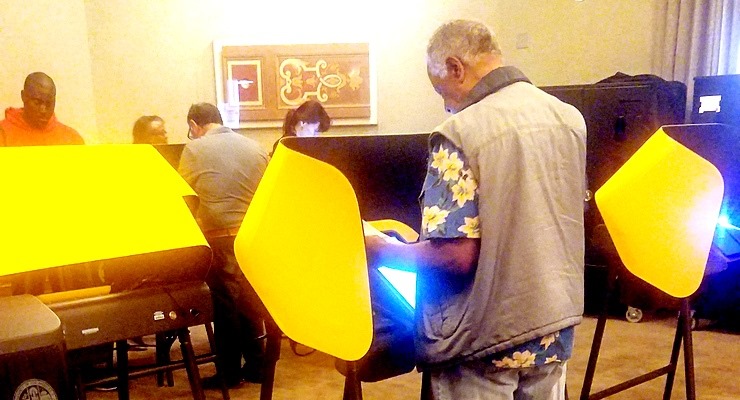








Editor’s note: In the first of a three-part series celebrating 50 years of Union Station Homeless Services, Pasadena Now looks at the history, present and future of the social service agency and its work.
It all began in the early ‘70s in a tiny storefront when members of All Saints Episcopal Church and some local Pasadena residents started to see “people on the streets.”
Since that time, the little storefront on Union Street became Union Station Homeless Services, and it grew exponentially over the next 50 years, to become the San Gabriel Valley’s largest social service agency helping homeless adults and families.
“Back then,” said current CEO Anne Miskey, in a recent interview, “it was a woman named Alice Callaghan and some members of All Saints Episcopal Church who were the ones that really brought attention to this issue.”
“It was a place to really welcome people who were unhoused, offer them a cup of coffee and really show them some human compassion,” she recalled. “So, that’s how it started, very simple, really, as a result of people saying, ‘Hey, it’s not right that people are living on the streets and what can we do about it?’”
As Miskey explained, the explosion of homelessness throughout the US, is actually, quite a modern phenomenon.
“Actual homelessness like we see now, started in the 1970s,” she said, “especially with the end of the Vietnam War and soldiers coming back. But where we really saw the increase in homelessness was the early 1980s. We went from just small, small numbers across the country to literally millions of people in the early eighties becoming homeless. And it was directly as a result of Federal policies.”
The disinvestment in affordable housing, the movement of jobs and manufacturing overseas, along with the implementation of (Economist Milton) Friedman-style “shareholders first” business policies, eventually created a fast-moving firestorm of homeless men, women and families across the country, said Miskey. There is a current population of 69,144 people experiencing homelessness in Los Angeles County, according to the latest count in January 2022.
“It was about housing and the lack of affordable housing back then,” Miskey stressed. And so that’s where Union Station kind of grew up at that time where we just really saw the need and the local community responded. But again, in our early days, our help was ‘compassion focused,’ which is always a good thing. But we really didn’t talk about ‘How do we actually solve people’s homelessness? How do we get them off the streets?’
“And I think the realization came not just on the part of Union Station,” she continued, “but nationally, that we had to do more than make people comfortable while they were experiencing homelessness. We had to actually figure out ‘How do we end this, both on an individual basis and on a society’s basis?’”
In 1983, Dennis Pettigrew, a regular patron of Union Station, died of exposure while sleeping on a bus bench. Determined to prevent such a tragedy from ever happening again, Union Station, together with six downtown Pasadena congregations, opened The Depot, a 22-bed shelter located in the First Congregational Church.
In 1985, Union Station formalized its efforts by forming as a 501(c)(3) non-profit organization.
With the support of civic and religious leaders from the greater Pasadena community, Union Station completed a $1.3 million capital campaign in 1989 and opened the Adult Center, a 6,500 square-foot 36-bed shelter on South Raymond Avenue.
In the 1990’s, Union Station’s focus expanded beyond just meals and shelter, and it began helping clients address the root causes of homelessness by providing extensive support services and case management to help them achieve lasting self-sufficiency and stability.
In the late 1990s, Union Station experienced a new phenomenon—a dramatic increase in the number of women and families seeking services. In response, Union Station opened Rachel’s Center to address the special needs of homeless families.
Located in a two-bedroom bungalow in Pasadena, Rachel’s Center was equipped with playground equipment, toys, and a full kitchen. Rachel’s Center operated until 2003, when the Family Center opened.
For Miskey, the solution is simple, and the implementation is harder, but doable.
“If we’re going to end homelessness for people or help people end their homelessness, they have to have a home because that’s what homelessness is, is not having a home. Right?”
Thus, Miskey explained, in 2010 Union Station began to concentrate on developing actual housing, eventually teaming up with 130 San Gabriel Valley partner agencies.
“We saw a dramatic reduction in homelessness in Pasadena at that time,” said Miskey. “As we started focusing on homelessness, we went from about 1500 people experiencing homelessness to around 500 to 600 after that.”
In 2014, Union Station was designated by the County of LA to be the lead homeless agency for the San Gabriel Valley.
And then in 2015, Measure H was passed by LA County voters to help implement the Homeless Initiative created by the LA County Board of Supervisors—a 1/4-cent sales tax to create the first revenue stream dedicated to addressing and preventing homelessness.
“With that”, said Miskey, “we went from an agency of about 50 to 60 staff to now around 300 staff, and we serve 32 cities and a number of unincorporated areas across the San Gabriel Valley.
Come the present, the COVID-19 pandemic created its own brand new dilemma. Having people live on the streets now had direct and serious life-and-death health implications.
City leadership moved to create housing from little used hotels and motels scattered across the county, along with a “housing first” policy to move homeless more swiftly along the path to a roof over their heads.
“I think the hotels were a great initiative,” said Miskey “And of course, they really came because of Covid, needing to get people off the streets. The hotels have been very successful because it gives people privacy. It gives them their own room, their own bathroom. We make sure people have microwaves and little refrigerators. It gives people a measure of independence and safety. And we find that people do so much better that way.”
Our focus on housing and wraparound services has not changed, she stressed.
“We have seen over the years,” she continued, “that those two elements together, getting people into permanent, stable housing and then providing very deep wraparound services for whatever they need, has been incredibly successful for us and more importantly, for the people that we serve.”
She notes proudly, “Right now we have a housing retention rate of 97%. What that means is that 97% of the clients that we get into housing don’t become homeless again.”
For more about Union Station Homeless Services, click here.


















